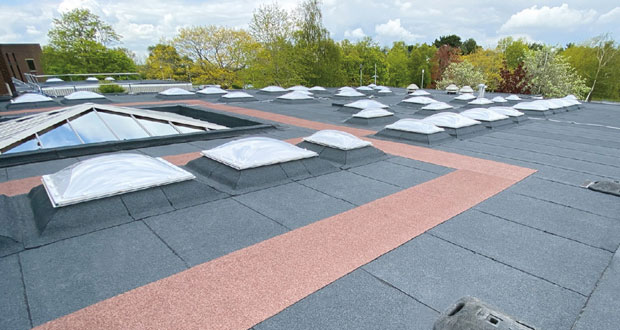 When is the right time to repair or replace a commercial roof? Dale Thomas, Technical Manager, Garland UK provides a comprehensive guide
When is the right time to repair or replace a commercial roof? Dale Thomas, Technical Manager, Garland UK provides a comprehensive guide
Regular inspections and annual maintenance of a commercial roof should always form an essential part of asset and facilities management. It helps to preserve the waterproofing membrane, prevent drainage issues and spot any potential problems before they can progress, allowing repairs to be made quickly and cost-effectively. But how do you determine the right time to perform repairs and when it is finally time to replace the roof? This guide will give you the knowledge you need to answer these questions.
Roofing is a substantial investment in your building, so maximising its lifespan ensures you get the best return on investment possible. However, at a certain point, everything, no matter how well looked after, reaches the end of its useable life. Repairs at this point will provide diminishing returns compared to the advantages of a complete roof replacement.
If you have safe access, you can visually inspect your roof to look for any early signs of damage or potential problems before they deteriorate. This allows you to contact your roofing specialist as soon as possible, hopefully well before there is any failure in the waterproofing. From here, they can perform a detailed roofing survey and perform any necessary investigative work to establish the cause of the problem and how best to it can be resolved.
SIGNS OF A DAMAGED COMMERCIAL ROOF
The first step is to identify the signs that your roof may be damaged. The table below lists all the signs of damage to your roof and that it’s time to arrange a roof survey.
|
Sign of Damage |
Location |
Explanation |
|
Ponding water |
External |
|
|
Gaps in seams |
External |
Roofs are constantly subjected to slight movement, ranging from expansion and contraction in hot and cold weather to movement in the building structure. Over time, this movement can lead to gaps forming in the seams, allowing water to ingress over time. Equally, poor workmanship on installation can result in weakened gaps in the membrane seams, where watertight adhesion to the substrate has yet to be achieved from the outset. |
|
Deteriorated flashing |
External |
Flashing is an often neglected part of the roofing structure. While good detailing and installation of flashings in your roof will significantly extend its usable lifespan, over time, it can begin to deteriorate from UV exposure, physical damage, and, again, movement in the building structure. As a result, it can fail or become loose, which in turn will cause leaks to occur. |
|
Ageing |
External |
All materials have a lifespan during which they will remain effective. UV exposure, movement and physical damage will all eventually take their toll on the roofing structure. Spotting signs that the surface roof structure is nearing the end of its life cycle before it fails will provide you with significantly more options for repair before a complete roof replacement is necessary. The three previous points are indicators of an ageing roof structure. In addition, a key indicator of ageing in your bitumen membrane is alligatoring, a crazed cracking pattern in the surface, which, as the name suggests, looks similar to the skin of an alligator. If left unattended, this will only deteriorate further, eventually causing the roof to fail. |
|
Blistering |
External |
Blistering is caused when pockets of air or moisture become trapped between layers of the roofing membrane or the roof deck. As the sun warms the roof’s surface, these pockets expand, stretching the roofing membrane and causing blistering. Blistering in and of itself is not necessarily a problem, as the roof can accommodate some movements. Still, they need monitoring to ensure that the surface is not detaching from the blistered area, that they have not caused any cracking in the surface membrane and that the blister is not near a seam, which may cause the seam to open for water to ingress. |
|
Organic growth |
External |
|
|
Debris in gutters |
External |
As part of the regular inspection and maintenance of the roof, it is essential to clear built-up debris from the roof surface and gutters. This allows water to run freely into the drainage system as intended, stopping prolonged water retention on the roof structure. If this has been neglected, it can allow for prolonged water retention that should be avoided, putting increased stress on the roofing structure, which can cause the roofing system to fail over time. |
|
Peeling wallpaper |
Internal |
While this is not ideal, early action is the key to resolving these problems before they can deteriorate further, keeping repair time and costs minimal. |





